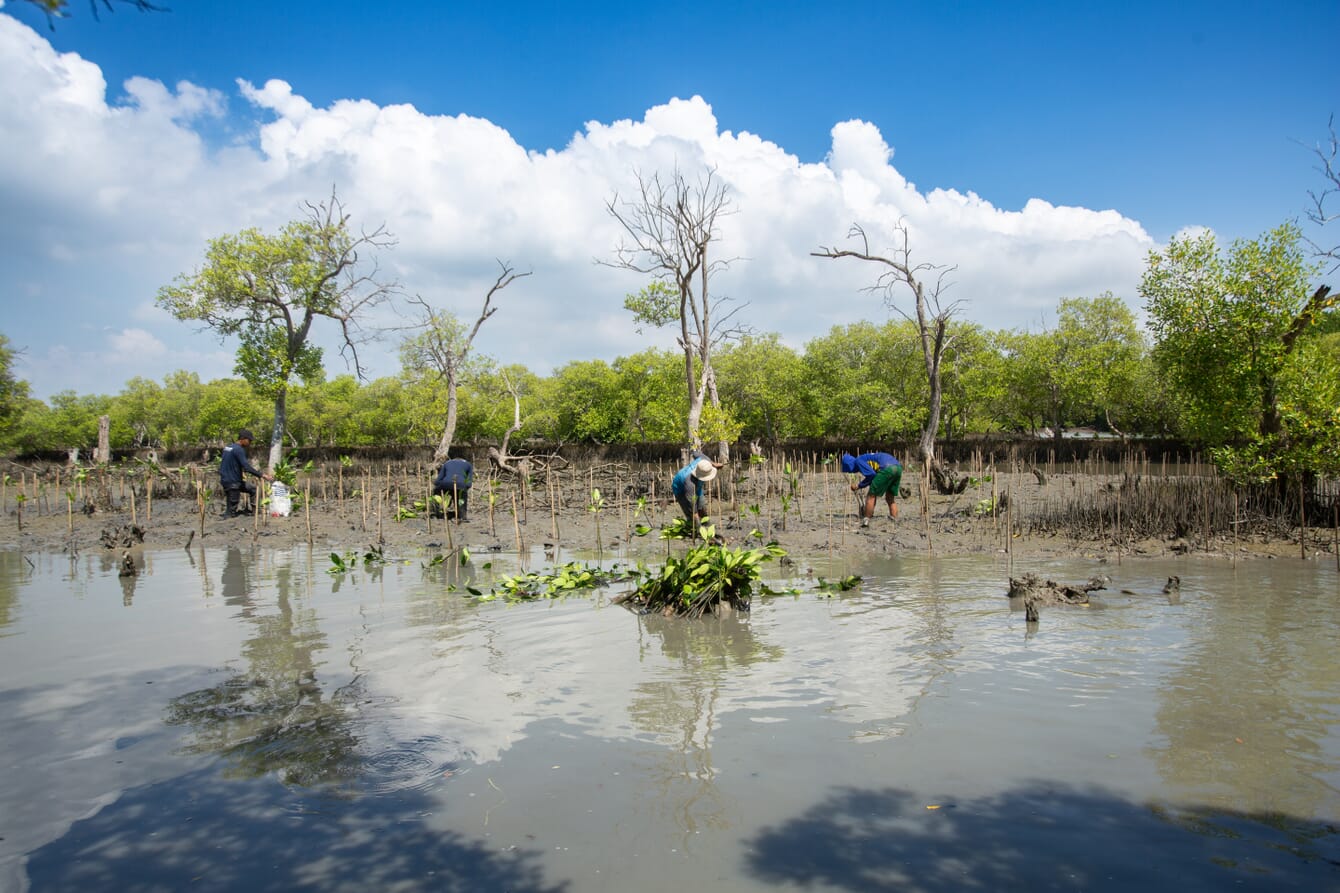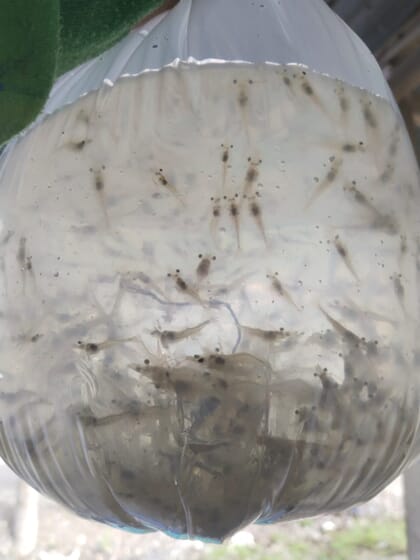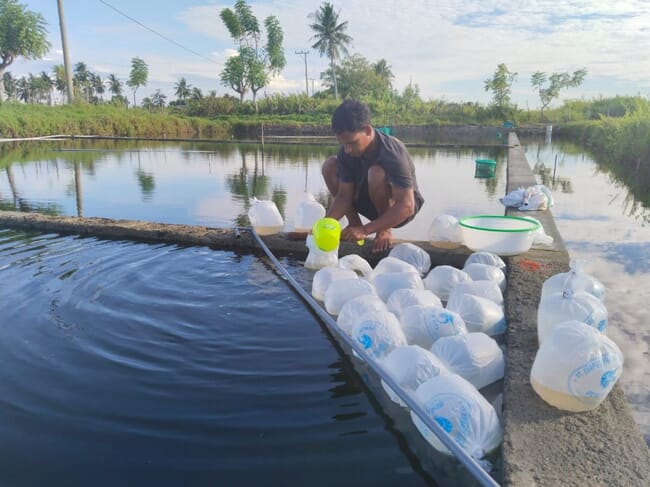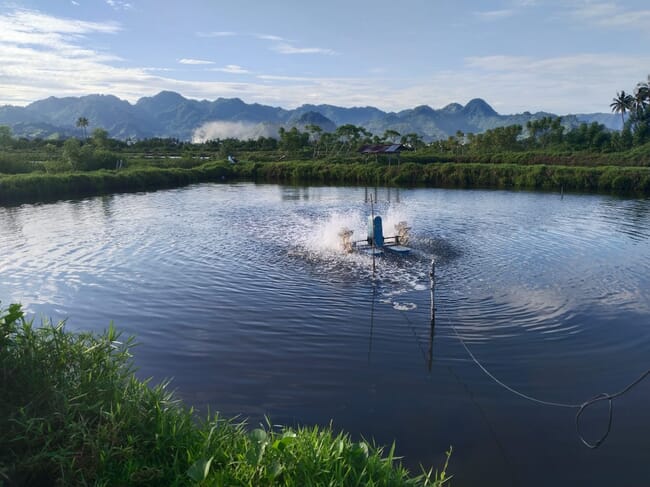
© Venambak
Innovation in aquaculture isn't always about high-tech solutions that lead to significant productivity increases. It can also involve enhancing existing systems through the use of better management practices and suitable technologies, sometimes aiming to create more positive social and environmental outcomes.
In Indonesia, shrimp farming systems vary widely, ranging from traditional to semi-intensive and intensive scales. However, innovation in shrimp aquaculture rarely targets traditional farmers, who account for around 170,000 households and manage approximately 300,000 hectares of ponds – typically producing about 200-500 kg of shrimp per hectare per year. While traditional ponds cover up to six times more land than semi-intensive and intensive ponds, their contribution to overall national production is less than 20 percent.
Recognising the significant potential offered by these extensive ponds, the Indonesian Shrimp Forum (FUI), The Global Quality and Standards Programme (GQSP) Indonesia and other stakeholders have recently been promoting upgrading traditional shrimp farming systems to "traditional-plus". The goal is to increase pond productivity from 0.2 - 0.5 tonnes to at least 0.8 - 2 tonnes per hectare per year, by implementing standard operating procedures (SOPs) and easy-to-adopt technologies. This approach carefully considers the costs and the farmers' capacity to understand and apply the new methods.
Traditional-plus SOPs have been demonstrated at roadshows in traditional shrimp farming centers, with the programme being piloted in several locations, including South Sulawesi, West Sulawesi, Lampung, East Java and West Java. The SOPs cover all production aspects, including pond preparation, water preparation, seed selection, feed and water quality management, disease management, and the implementation of a simple two-stage system (nursery and grow-out), which is not yet widely practiced in Indonesia.

© Sugeng Riyanto
Enhancing pond readiness
Sugeng Riyanto, a traditional-plus shrimp farmer, tells The Fish Site that traditional shrimp farming typically involves stocking seeds at very low densities (less than five shrimp per m2) and waiting until harvest time, without additional feed, or technology. The traditional-plus system, however, introduces simple technology and SOPs, which means the stocking density can be slightly increased to at least 5-8 shrimp per m2.
Riyanto started using this system about 20 years ago in Mamuju, West Sulawesi. He created his own SOPs and has been teaching them to traditional shrimp farmers ever since. Today, around 100 traditional farmers in his area are cooperating with him to learn and implement the traditional-plus system.
According to him, the most crucial aspect of the SOP is to always choose specific pathogen-free (SPF) post-larvae (PLs) from reliable hatcheries to minimise risks in the ponds. Additionally, preparation practices that are rarely done by traditional farmers but have a significant impact include land preparation, such as ploughing and applying lime and probiotics. Traditionally, farmers have often overlooked proper pond preparation.
“In 2008, I first brought vannamei from Java. At that time, I only had 10 farmers following me in the first year because, in Makassar, there weren’t many buyers for vannamei shrimp – just in the local market. But I stayed motivated, even though it was tough. We kept trying with the farmers, and eventually, this method spread. Now, this area has even become a model for others,” he recalls.

© Sugeng Riyanto
A two-stage system
Among the various steps typically related to basic practices for optimising shrimp growth, the two-stage approach used in Riyanto's traditional-plus system is rarely implemented in Indonesia, even in intensive systems. This approach is now being adopted and is becoming a key component of the SOPs developed by FUI and GQSP.
Riyanto notes that the use of juveniles in grow-out ponds has a significant impact because PLs from hatcheries are first reared for 2-3 weeks in smaller and controlled ponds before being transferred to larger grow-out ponds, which helps them adapt better. He manages the nursery with a stocking density of 200 shrimp per m2, using PLs feed and aerators at specific times to ensure adequate oxygen levels. During this critical nursery phase, land preparation is further enhanced with disinfection to minimise pathogen outbreaks.
The two-step concept is simpler to implement in traditional ponds than in intensive systems and is actually quite common in Ecuador. According to Riyanto, this system improves survival rates at the grow-out phase from around 30 percent to 70-80 percent.
Another relatively simple improvement in the SOPs for traditional farmers is the use of probiotics at each stage. Riyanto typically applies 10 ppm of probiotics during the nursery phase and 5 ppm in the grow-out ponds. To reduce costs, he cultures the probiotic inoculant in advance, by mixing 500 ml of probiotics with 10 litres of water.

© Sugeng Riyanto
Regarding feed management, Sugeng notes that his farmers don't always feed the shrimp during the grow-out phase, particularly when stocking densities are low. Some farmers only provide regular feed as a final step, 1-2 weeks before harvest. With this approach, a 2-month grow-out period can produce shrimp of 12.5 grams, which is already marketable. He says that to achieve this size, the farmers' production costs are around IDR 30,500 per kg, while they receive around IDR 50,000 per kg at the farm gate. In comparison, the average production cost for intensive farming is around IDR 42,500 per kg.
In various instances, Prof Sukenda from IPB University – who is the technical consultant for the traditional-plus shrimp farming project by FUI and GQSP – has mentioned that there are many areas within the SOPs that farmers can choose from to enhance their traditional ponds, based on their capabilities. These includes using feed and aerators, which can allow them to slightly increase stocking density. In his trials, a density of 15-18 shrimp per m2 resulted in annual productivity of 1.9 - 2.1 tonnes. He recommends starting additional feeding after 10 days, with feed containing 28-30 percent protein, and using aerators after 14 days, operating from evening until morning.
The use of aeration in traditional shrimp farming is also being promoted by the startup Venambak. To positively impact traditional farmers, Venambak encourages farmers in West Java to enhance their pond carrying capacity and productivity by using aerators. According to Achmad Jerry, CEO of Venambak, the company is also developing solar-powered aerators to address the needs of traditional ponds that lack access to electricity infrastructure. This is also part of their mission for low-carbon aquaculture.
The traditional-plus system appears easy to implement across Indonesia, but it faces significant challenges. According to Prof Sukenda, the biggest hurdle is the mindset: not all traditional farmers are open to changing their methods, especially when it involves additional costs, even if it promises higher yields.
In addition, infrastructure is also a challenge, especially the channels used for moving water into and out of the ponds, which are becoming shallower since they are typically shared among traditional farmers. Riyanto hopes the government can support the construction of dedicated inlet and outlet channels for traditional farmers, ensuring better control of water flow and reducing the risk of disease spread.

© Venambak
Optimising blue carbon benefits
In addition to its direct productivity benefits for shrimp ponds, the traditional-plus system has significant potential when integrated with mangroves, a concept known as silvofishery. Some traditional farmers are already aware of the ecological advantages of this “old, but gold” concept, both for enhancing pond productivity and benefiting the environment. However, neither sandy ponds nor those without tides are not suited to this model.
These days, mangroves are also recognised for their significant additional benefits. They play a crucial role in fighting climate change because they absorb large amounts of carbon. As countries around the world commit to reducing their emissions, farmers can potentially monetise mangrove ecosystems through carbon trading.
Although carbon trading is still developing in Indonesia, many companies are actively working to reduce their environmental impact by minimising their own emissions. This often involves carbon offset programmes and CSR initiatives that support organisations or groups managing natural carbon sequestration, such as forest rangers and mangrove stewards.
Jerry and his team are working to maximise the benefits of the silvofishery concept, recently planting 20,500 mangrove seedlings with funding from Telkom and JNE CSR programmes.
In conclusion, the traditional-plus shrimp farming system in Indonesia offers a promising way to boost national shrimp production by improving traditional farming practices with simple technologies and better management. While the system has the potential to increase productivity and offer environmental benefits, challenges like farmer mindset and infrastructure limitations need to be addressed for widespread adoption. Integrating these practices with ecological approaches like the silvofishery concept could further enhance sustainability and open up new opportunities, such as carbon trading, for farmers.




